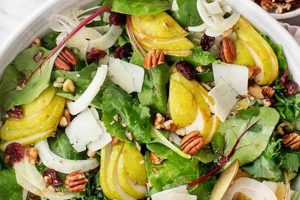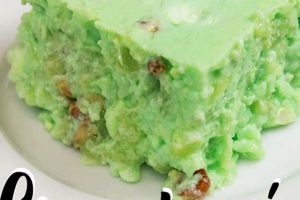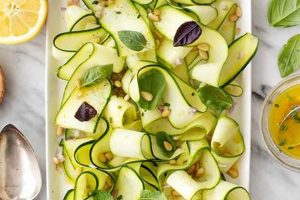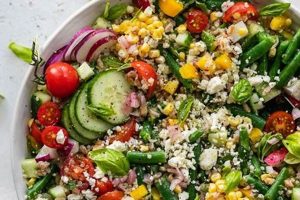A blend of young, tender greens typically including spinach, romaine lettuce, red leaf lettuce, and other lettuces like oak leaf, arugula, or mizuna forms the foundation of dishes featuring this versatile ingredient. These vibrant mixes offer a convenient and nutritious base for a wide variety of salads. For example, a simple preparation might involve tossing the greens with a light vinaigrette, crumbled feta cheese, and toasted walnuts.
The popularity of these mixed green salads stems from several factors, including convenience, nutritional value, and culinary versatility. Packed with vitamins, minerals, and antioxidants, these blends contribute to a healthy diet. Furthermore, their delicate flavors and textures readily complement diverse ingredients, from simple vinaigrettes to more complex dressings and toppings, allowing for endless culinary creativity. Historically, the practice of combining various greens in salads reflects a shift towards appreciating the diverse flavors and textures offered by different lettuces, moving beyond the use of single-variety salads like iceberg or romaine.
The following sections will explore various aspects of creating delicious and healthy salads using these mixed greens, from selecting the freshest ingredients and crafting complementary dressings to exploring creative flavor combinations and presentation techniques.
Tips for Creating Exceptional Salads with Mixed Greens
Achieving a truly delicious and satisfying salad experience relies on careful attention to detail, from ingredient selection to final presentation. These tips offer guidance on elevating mixed green salads to new culinary heights.
Tip 1: Prioritize Freshness: Select vibrant, crisp greens free from wilting or discoloration. Store unwashed greens in a sealed container lined with a paper towel in the refrigerator for optimal preservation.
Tip 2: Wash and Dry Thoroughly: Gently wash the greens and thoroughly dry them using a salad spinner or clean kitchen towels. Excess moisture dilutes dressings and makes the salad soggy.
Tip 3: Dress Strategically: Add dressing just before serving to prevent the greens from wilting. Toss gently to ensure even coating without bruising the delicate leaves.
Tip 4: Balance Flavors and Textures: Consider incorporating a variety of textures and flavors. Crunchy elements like nuts, seeds, or croutons provide contrast to the tender greens. Sweet or tangy fruits, cheeses, and proteins add depth of flavor.
Tip 5: Explore Dressing Options: Experiment with different dressings to enhance the flavor profile of the salad. A classic vinaigrette, creamy dressing, or even a simple lemon-herb dressing can complement the mixed greens beautifully.
Tip 6: Consider Seasonal Ingredients: Utilize seasonal produce for optimal flavor and nutritional value. Spring vegetables like asparagus and peas, summer tomatoes and berries, or autumnal squash and apples all create unique and delicious salads.
Tip 7: Artful Presentation: Consider the visual appeal of the salad. Arrange the ingredients thoughtfully, creating a visually appealing and enticing presentation.
By focusing on these tips, one can consistently create flavorful, visually appealing, and nutritionally rich salads that highlight the delicate nature and versatility of mixed greens.
These fundamental principles provide a solid foundation for crafting exceptional salads. The following section will delve into specific recipe ideas that showcase the potential of mixed greens in various culinary applications.
1. Fresh, High-Quality Greens
The foundation of any successful spring mix salad lies in the selection of fresh, high-quality greens. These greens provide not only the base structure but also contribute significantly to the overall flavor, texture, and nutritional value. The vibrant colors and crisp textures of fresh greens signal optimal quality and contribute to a more satisfying sensory experience. Compromised greens, whether wilted, bruised, or discolored, detract from both the visual appeal and the overall enjoyment of the salad. The difference between a salad made with vibrant, crisp spinach and one made with limp, yellowing leaves is readily apparent. This principle directly impacts recipe development, as the quality of the greens influences the choice of complementary ingredients and dressings.
Several factors contribute to the importance of fresh greens in these recipes. Nutrient density is highest in freshly harvested produce, and the delicate flavors of young greens are best appreciated when consumed soon after picking. Moreover, fresh greens maintain their structure better when tossed with other ingredients and dressings, preventing a soggy or wilted salad. Practical applications of this understanding include careful selection at the point of purchase, proper storage techniques to maintain freshness, and timely preparation to maximize quality. For example, storing spring mix in a container lined with paper towels helps absorb excess moisture and prolongs its shelf life.
Ultimately, prioritizing fresh, high-quality greens elevates spring mix salads from simple meals to culinary experiences. This emphasis on quality ingredients ensures optimal flavor, texture, and nutritional value. While challenges such as seasonal availability and proper storage can influence access to high-quality greens, the payoff in terms of taste and overall satisfaction justifies the effort. This principle underscores the essential connection between ingredient quality and the success of any recipe featuring spring mix.
2. Complementary Ingredients
Complementary ingredients play a crucial role in elevating spring mix salads from simple to exceptional. These additions provide textural contrast, introduce diverse flavor profiles, and enhance the overall nutritional value. The delicate flavors of spring mix create a versatile canvas for a wide array of ingredients, allowing for endless culinary creativity. The interplay between the base greens and carefully chosen additions transforms a basic salad into a balanced and satisfying meal. For example, the subtle bitterness of arugula in a spring mix pairs well with the sweetness of dried cranberries and the creamy richness of goat cheese, creating a harmonious balance of flavors and textures.
The selection of complementary ingredients should consider factors such as flavor compatibility, textural contrast, and nutritional balance. Adding crunchy elements like toasted nuts, seeds, or croutons provides a satisfying counterpoint to the tender greens. Sweet or tangy fruits, such as berries, apples, or citrus segments, introduce brightness and complexity. Cheese crumbles, chopped hard-boiled eggs, or grilled chicken or fish offer protein and enhance satiety. Consider the overall flavor profile desired whether sweet, savory, tangy, or spicy when selecting complementary ingredients. A Mediterranean-inspired salad might include feta cheese, Kalamata olives, and cucumber, while a more Asian-inspired version could incorporate mandarin oranges, edamame, and toasted sesame seeds. Understanding these principles allows for informed decisions when crafting a balanced and delicious spring mix salad.
Successful integration of complementary ingredients hinges on thoughtful consideration of the interplay between flavors and textures. Overcrowding the salad can detract from the delicate nature of the greens and create a dish that feels heavy or unbalanced. Strategic placement of ingredients enhances visual appeal and allows individual flavors to shine. While culinary creativity is encouraged, maintaining a sense of balance ensures a harmonious and enjoyable dining experience. Potential challenges include balancing flavor profiles and avoiding ingredient combinations that clash or overpower the delicate greens. However, thoughtful planning and attention to detail ultimately transform spring mix salads into culinary masterpieces.
3. Balanced Flavor Profiles
Balanced flavor profiles are essential for creating truly enjoyable spring mix salad recipes. The delicate nature of the mixed greens provides a neutral backdrop that allows for a wide range of flavor combinations. However, achieving a harmonious blend requires careful consideration of the interplay between different tastessweet, sour, salty, bitter, and umamiand how they interact with the inherent flavors of the greens themselves. A well-balanced salad avoids extremes, ensuring that no single flavor dominates and that each element complements the others.
- Acidity
Acidity, often introduced through vinaigrettes or citrus segments, plays a crucial role in balancing the flavors of a spring mix salad. The bright, tangy notes cut through the richness of other ingredients, such as cheese or nuts, and enhance the overall freshness of the greens. A lemon vinaigrette, for instance, can brighten a salad featuring creamy goat cheese and candied pecans. The level of acidity should be carefully calibrated to complement, not overpower, the other flavors.
- Sweetness
Sweetness, often derived from fruits like berries, apples, or dried cranberries, adds a dimension of complexity to spring mix salads. It contrasts beautifully with the slight bitterness sometimes present in greens like arugula or radicchio. The addition of roasted sweet potatoes or a honey-mustard dressing can also introduce subtle sweetness. Balancing sweetness with other flavor components, such as acidity or saltiness, prevents the salad from becoming cloying.
- Saltiness and Umami
Saltiness enhances the flavors of other ingredients and provides a savory counterpoint to sweetness and acidity. Cheese crumbles, olives, or a sprinkle of sea salt contribute saltiness. Umami, the savory fifth taste, can be introduced through ingredients like roasted nuts, mushrooms, or a Parmesan vinaigrette. These elements add depth and complexity to the salad, rounding out the flavor profile. A salad featuring grilled halloumi, toasted walnuts, and a balsamic glaze exemplifies the interplay of saltiness, umami, and other flavor components.
- Bitterness
While often perceived negatively, bitterness can add a desirable complexity to spring mix salads. The peppery bite of arugula or the slightly bitter notes of radicchio offer intriguing contrasts to sweeter or richer ingredients. Balancing bitterness with other flavors is key; too much can make the salad unpalatable. Pairing bitter greens with sweet fruits or creamy cheeses creates a balanced and enjoyable flavor profile.
By carefully considering the interplay of these flavor components, one can create spring mix salads that are not only nutritionally balanced but also offer a delightful sensory experience. The delicate nature of the greens allows for a wide range of flavor combinations, but attention to balance ensures that each ingredient contributes to a harmonious whole. A successful spring mix salad is a testament to the art of combining contrasting flavors to create a dish that is both refreshing and satisfying.
4. Creative Dressings
Creative dressings are integral to successful spring mix salad recipes, transforming a simple collection of greens into a flavorful and engaging culinary experience. Dressings provide more than just moisture; they contribute significantly to the overall flavor profile, texture, and visual appeal of the salad. The delicate nature of spring mix allows a wide range of dressing styles, from light and tangy vinaigrettes to creamy and herbaceous blends. A thoughtfully crafted dressing complements the inherent flavors of the greens and other salad components, unifying the dish and enhancing its complexity. For example, a vibrant raspberry vinaigrette can brighten a spring mix salad with goat cheese and toasted almonds, while a creamy avocado dressing complements a salad with grilled chicken and black beans. The cause-and-effect relationship is clear: the choice of dressing directly impacts the overall sensory experience of the salad.
The importance of creative dressings lies in their ability to elevate spring mix salads beyond the ordinary. A simple vinaigrette can be transformed into something special with the addition of fresh herbs, spices, or a touch of sweetness. Exploring different flavor combinations and textures within the dressing itself adds depth and intrigue to the salad. Consider a maple-dijon vinaigrette with toasted pecans or a tahini-ginger dressing with sesame seeds. These creative combinations not only enhance the taste of the salad but also add visual interest. Practical applications include experimenting with different oils, vinegars, and flavoring agents to develop unique dressings tailored to specific ingredient combinations. Understanding flavor pairings, such as the affinity of balsamic vinegar with strawberries or the complementary nature of lemon and dill, allows for the creation of harmonious and well-balanced salads.
Ultimately, creative dressings function as the unifying element in spring mix salad recipes. They tie together the various components, creating a cohesive and satisfying culinary experience. The ability to craft dressings that complement the chosen ingredients elevates the salad from a simple side dish to a star attraction. Challenges may include balancing flavors and avoiding dressings that overpower the delicate greens. However, the potential for culinary exploration and the ability to transform simple ingredients into something extraordinary make the pursuit of creative dressings a rewarding endeavor in the realm of spring mix salads.
5. Proper Storage Techniques
Proper storage techniques are crucial for maintaining the quality and freshness of spring mix, directly impacting the success of related recipes. Delicate greens are susceptible to wilting and deterioration if not handled and stored correctly. Optimal storage preserves the crisp texture, vibrant color, and nutritional value of the spring mix, ensuring that it remains a desirable base for salads. Improper storage leads to wilted, discolored greens, compromising the overall appeal and flavor of the final dish. For example, storing spring mix in a sealed plastic bag without proper ventilation traps moisture, accelerating spoilage. Conversely, storing the greens in a perforated container lined with a paper towel within the refrigerator maintains optimal humidity and extends shelf life. This cause-and-effect relationship underscores the importance of proper storage as a foundational element in successful spring mix salad recipes.
The significance of proper storage extends beyond mere preservation; it directly influences the sensory experience of the final dish. Fresh, properly stored greens contribute a crisp texture and vibrant flavor to the salad, enhancing the enjoyment of the meal. Wilted or discolored greens, on the other hand, detract from the overall appeal and can even impart unpleasant flavors. Practical applications of proper storage techniques include storing spring mix in a designated refrigerator drawer, away from ethylene-producing fruits like apples and bananas, which can accelerate spoilage. Additionally, washing the greens only when ready to use and ensuring they are thoroughly dried before storage helps prevent premature wilting. These practices maximize the shelf life of the spring mix and guarantee optimal quality for culinary applications.
In conclusion, proper storage techniques are essential for maximizing the quality and longevity of spring mix. This practice ensures that the greens remain a vibrant and flavorful component of any salad recipe. While challenges such as limited refrigerator space and varying storage recommendations for different greens may arise, the payoff in terms of flavor, texture, and overall satisfaction justifies the implementation of these techniques. This understanding highlights the integral connection between proper storage and the creation of successful and enjoyable spring mix salad recipes.
6. Appealing Presentation
Appealing presentation significantly enhances the dining experience of spring mix salad recipes. Visual appeal stimulates appetite and elevates perceived value, transforming a simple salad into a more enticing culinary creation. Thoughtful arrangement and attention to detail communicate care and craftsmanship, impacting overall enjoyment. A well-presented salad encourages consumption and contributes to a more positive perception of the dish, even before the first bite.
- Color and Contrast
Vibrant colors and contrasting textures create visual interest. A mix of greens provides a foundation, while colorful vegetables like bell peppers, tomatoes, and radishes add vibrancy. Textural contrast, achieved through elements like toasted nuts, crumbled cheese, or crunchy croutons, further enhances visual appeal. A salad featuring dark leafy greens, bright orange carrots, and creamy white feta cheese exemplifies effective use of color and contrast.
- Height and Dimension
Creating height and dimension adds depth and visual appeal. Avoid a flat, one-dimensional presentation by strategically placing ingredients. Mounding the salad in the center of the plate or using a cookie cutter to create a defined shape adds visual interest. Incorporating taller elements, such as cucumber ribbons or whole cherry tomatoes, creates a more dynamic presentation. A salad with layers of mixed greens, grilled chicken, avocado slices, and a sprinkle of microgreens demonstrates the impact of height and dimension.
- Plate Selection and Garnishes
The choice of plate influences the overall presentation. A plain white plate provides a neutral backdrop that allows the colors of the salad to stand out, while a patterned plate can complement or contrast with the ingredients. Appropriate garnishes, such as a sprinkle of fresh herbs, a drizzle of balsamic glaze, or edible flowers, add a final touch of elegance. A Caprese salad served on a dark slate plate with a basil sprig exemplifies the impact of plate selection and garnishes.
- Portion Size and Arrangement
Appropriate portion size and careful arrangement contribute to an appealing presentation. Overcrowding the plate makes the salad appear less appealing and can make it difficult to eat. Leaving some negative space on the plate enhances visual appeal. Thoughtful arrangement of ingredients, such as placing larger elements around the perimeter and smaller elements in the center, creates a sense of balance and harmony. A Cobb salad with neatly arranged rows of chicken, bacon, tomatoes, and blue cheese demonstrates the impact of portion control and deliberate arrangement.
These facets of appealing presentation contribute significantly to the overall enjoyment of spring mix salad recipes. The visual appeal enhances the dining experience, making the salad more enticing and enjoyable. By understanding and applying these principles, one can elevate spring mix salads from simple meals to visually stunning culinary creations. The impact of presentation extends beyond aesthetics, influencing perception of flavor and overall satisfaction. Thoughtful presentation elevates the simplest spring mix salad, transforming it into a dish worthy of admiration and enjoyment.
Frequently Asked Questions about Spring Mix Salads
This section addresses common inquiries regarding spring mix salads, providing concise and informative responses to clarify potential uncertainties and enhance understanding of this versatile culinary subject.
Question 1: What types of greens are typically found in spring mix?
Spring mix typically comprises a blend of young, tender lettuces, including spinach, romaine, red leaf lettuce, oak leaf lettuce, arugula, and mizuna. Variations may occur depending on the producer and region.
Question 2: How should spring mix be stored to maintain optimal freshness?
Optimal storage involves placing unwashed spring mix in a sealed container lined with a paper towel within the refrigerator. This method helps absorb excess moisture and prevents premature wilting.
Question 3: How long can spring mix be stored before it begins to deteriorate?
Properly stored spring mix typically maintains peak freshness for 5 to 7 days. Visual inspection for wilting or discoloration is recommended to determine usability.
Question 4: What are some recommended complementary ingredients for spring mix salads?
Complementary ingredients vary widely depending on desired flavor profiles. Popular choices include fruits (berries, apples, citrus), vegetables (cucumber, carrots, bell peppers), nuts, seeds, cheeses, and proteins (grilled chicken, fish, tofu).
Question 5: What types of dressings work well with spring mix?
Spring mix’s delicate flavors pair well with a variety of dressings. Light vinaigrettes (balsamic, lemon, raspberry), creamy dressings (ranch, blue cheese), and simple oil-and-vinegar combinations complement the greens effectively.
Question 6: How can one prevent spring mix salads from becoming soggy?
Soggy salads are often the result of excess moisture. Thoroughly drying greens after washing and adding dressing immediately before serving helps maintain crispness.
Understanding these fundamental aspects contributes to creating delicious and satisfying spring mix salad experiences. By addressing these common queries, one can approach spring mix salad preparation with greater confidence and achieve optimal results.
This concludes the frequently asked questions section. The following sections will offer specific recipe ideas and variations showcasing the versatility of spring mix.
Spring Mix Salad Recipes
Exploration of spring mix salad recipes reveals the versatility and potential of this simple yet dynamic culinary foundation. From the selection of fresh, vibrant greens to the artful balance of complementary ingredients, flavor profiles, and creative dressings, each element contributes significantly to the overall dining experience. Proper storage techniques ensure optimal ingredient quality, while thoughtful presentation elevates the dish from basic sustenance to a visually appealing culinary creation. Understanding these interconnected principles empowers culinary enthusiasts to craft salads that are not only nutritionally balanced but also offer a delightful sensory experience.
The adaptability of spring mix encourages culinary creativity and exploration. The potential for diverse flavor combinations and presentations ensures that spring mix salads remain a refreshing and engaging culinary option. Continued exploration of flavor profiles, ingredient pairings, and presentation techniques promises further evolution and refinement within the realm of spring mix salad recipes, solidifying its position as a staple of healthy and enjoyable cuisine.






